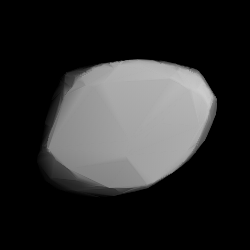
1743 Schmidt, provisional designation 4109 P-L, is a dark background asteroid from the inner regions of the asteroid belt, approximately 19 kilometers in diameter. It was discovered during the Palomar–Leiden survey on 24 September 1960, by astronomers Ingrid and Cornelis van Houten at Leiden, on photographic plates taken by Tom Gehrels at Palomar Observatory in California. The C-type asteroid has a rotation period of 17.5 hours. It was named for the optician Bernhard Schmidt.
Pawlowia, provisional designation 1923 OX, is a background asteroid from the central regions of the asteroid belt, approximately 20 kilometers in diameter. It was discovered on 5 October 1923, by Soviet astronomer Vladimir Albitsky at the Simeiz Observatory on the Crimean peninsula. The asteroid was named after Russian physiologist and Nobelist Ivan Pavlov.
La Paz, provisional designation 1923 PD, is a carbonaceous asteroid from the outer region of the asteroid belt, approximately 40 kilometers in diameter. It was discovered on 31 October 1923, by German astronomer Max Wolf at the Heidelberg-Königstuhl State Observatory and named after the city La Paz in Bolivia.
1024 Hale, provisional designation A923 YO13, is a carbonaceous background asteroid from the outer regions of the asteroid belt, approximately 45 kilometers (28 miles) in diameter. The asteroid was discovered on 2 December 1923, by Belgian–American astronomer George Van Biesbroeck at the Yerkes Observatory in Wisconsin, United States. It was named for American astronomer George Ellery Hale. The dark C-type asteroid may have a rotation period of 16 hours.

1081 Reseda is a dark background asteroid from the outer regions of the asteroid belt. It was discovered on 31 August 1927, by astronomer Karl Reinmuth at the Heidelberg-Königstuhl State Observatory in southwest Germany. The asteroid has a rotation period of 7.3 hours and measures approximately 37 kilometers in diameter. It was named after the herbaceous plant Reseda.
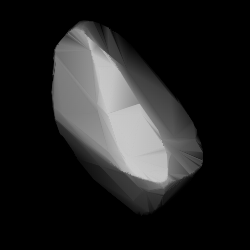
1119 Euboea is a background asteroid from the central region of the asteroid belt. It was discovered on 27 October 1927, by German astronomer Karl Reinmuth at the Heidelberg-Königstuhl State Observatory in southwest Germany. The asteroid has a rotation period of 11.4 hours and measures approximately 30 kilometers in diameter. It was named for the Greek island of Euboea.
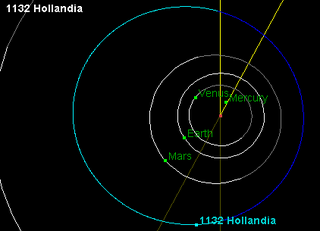
1132 Hollandia, provisional designation 1929 RB1, is a stony asteroid from the middle region of the asteroid belt, approximately 27 kilometers in diameter. It was discovered on 13 September 1929, by Dutch astronomer Hendrik van Gent at Leiden Southern Station, annex to the Johannesburg Observatory in South Africa. It was named for the region Holland in the Netherlands.

1147 Stavropolis is a stony background asteroid from the inner regions of the asteroid belt. It was discovered on 11 June 1929, by Georgian–Russian astronomer Grigory Neujmin at the Simeiz Observatory on the Crimean peninsula. The S-type asteroid has a rotation period of 5.7 hours and measures approximately 14 kilometers in diameter. It was named after the Russian city of Stavropol.
1159 Granada, provisional designation 1929 RD, is a dark background asteroid and relatively slow rotator from the inner regions of the asteroid belt, approximately 30 kilometers in diameter. It was discovered on 2 September 1929, by astronomer Karl Reinmuth at the Heidelberg Observatory in southwest Germany. The asteroid was named for the Spanish city and province of Granada.
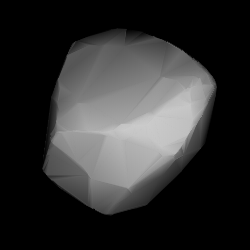
1457 Ankara, provisional designation 1937 PA, is a stony asteroid from the central region of the asteroid belt, approximately 18 kilometers in diameter. It was discovered on 3 August 1937, by German astronomer Karl Reinmuth at Heidelberg Observatory in southwest Germany, and later named for the Turkish capital city of Ankara.
1815 Beethoven, provisional designation 1932 CE1, is a carbonaceous background asteroid from the outer regions of the asteroid belt, approximately 30 kilometers (19 miles) in diameter. It was discovered on 27 January 1932, by German astronomer Karl Reinmuth at the Heidelberg Observatory. The uncommon F-type asteroid seems to have a long rotation period of 54 hours (tentative). It was named after Ludwig van Beethoven.
1295 Deflotte, provisional designation 1933 WD, is a carbonaceous asteroid from the outer regions of the asteroid belt, approximately 48 kilometers in diameter. It was discovered on 25 November 1933, by French astronomer Louis Boyer at the Algiers Observatory in Algeria, North Africa. The asteroid was named after the discoverer's nephew.
1541 Estonia, provisional designation 1939 CK, is an asteroid from the central regions of the asteroid belt, approximately 21 kilometers in diameter. It was discovered on 12 February 1939, by astronomer Yrjö Väisälä at the Iso-Heikkilä Observatory near Turku, Finland. The asteroid was named after the Baltic country of Estonia.
1271 Isergina, provisional designation 1931 TN, is a carbonaceous background asteroid from the outer regions of the asteroid belt, approximately 45 kilometers in diameter. It was discovered on 10 October 1931, by Soviet astronomer Grigory Neujmin at the Simeiz Observatory on the Crimean peninsula. The asteroid was named after Crimean physician and friend of the discoverer, Pyotr Isergin.
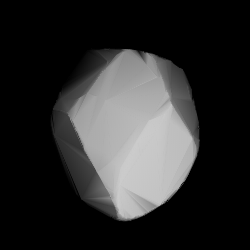
1281 Jeanne is a dark asteroid from the background population of the intermediate asteroid belt. It was discovered on 25 August 1933, by astronomer Sylvain Arend at the Royal Observatory of Belgium in Uccle, who named it after his daughter, Jeanne. The likely P-type asteroid has a rotation period of 15.2 hours and measures approximately 22 kilometers in diameter.
1303 Luthera, provisional designation 1928 FP, is a dark asteroid and the parent body of the Luthera family, located in the outermost regions of the asteroid belt. It measures approximately 90 kilometers in diameter. The asteroid was discovered on 16 March 1928, by astronomer Friedrich Schwassmann at the Bergedorf Observatory in Hamburg, Germany, and later named after German astronomer Robert Luther.

1332 Marconia, provisional designation 1934 AA, is a dark asteroid and the parent body of the Marconia family located in the outer regions of the asteroid belt. It measures approximately 46 kilometers in diameter. The asteroid was discovered on 9 January 1934, by Italian astronomer Luigi Volta at the Observatory of Turin in Pino Torinese, northern Italy. It was named for Italian electrical engineer Guglielmo Marconi. The uncommon L-type asteroid has a rotation period of 19.2 hours.
3066 McFadden, provisional designation 1984 EO, is a stony background asteroid from the central regions of the asteroid belt, approximately 15 kilometers in diameter. It was discovered on 1 March 1984, by American astronomer Edward Bowell at the Anderson Mesa Station near Tucson, Arizona. It was named for American planetary scientist Lucy-Ann McFadden. The assumed S-type asteroid has a rotation period of 13.8 hours.
2043 Ortutay, provisional designation 1936 TH, is a dark asteroid from the outer regions of the asteroid belt, approximately 45 kilometers in diameter. The asteroid was discovered by Hungarian astronomer György Kulin at the Konkoly Observatory, Budapest, on 12 November 1936. It was named after Hungarian ethnographer Gyula Ortutay.
1461 Jean-Jacques, provisional designation 1937 YL, is a metallic asteroid from the outer region of the asteroid belt, approximately 34 kilometers in diameter. It was discovered on 30 December 1937, by French astronomer Marguerite Laugier at Nice Observatory in southern France, who named it after her son Jean-Jacques Laugier.








